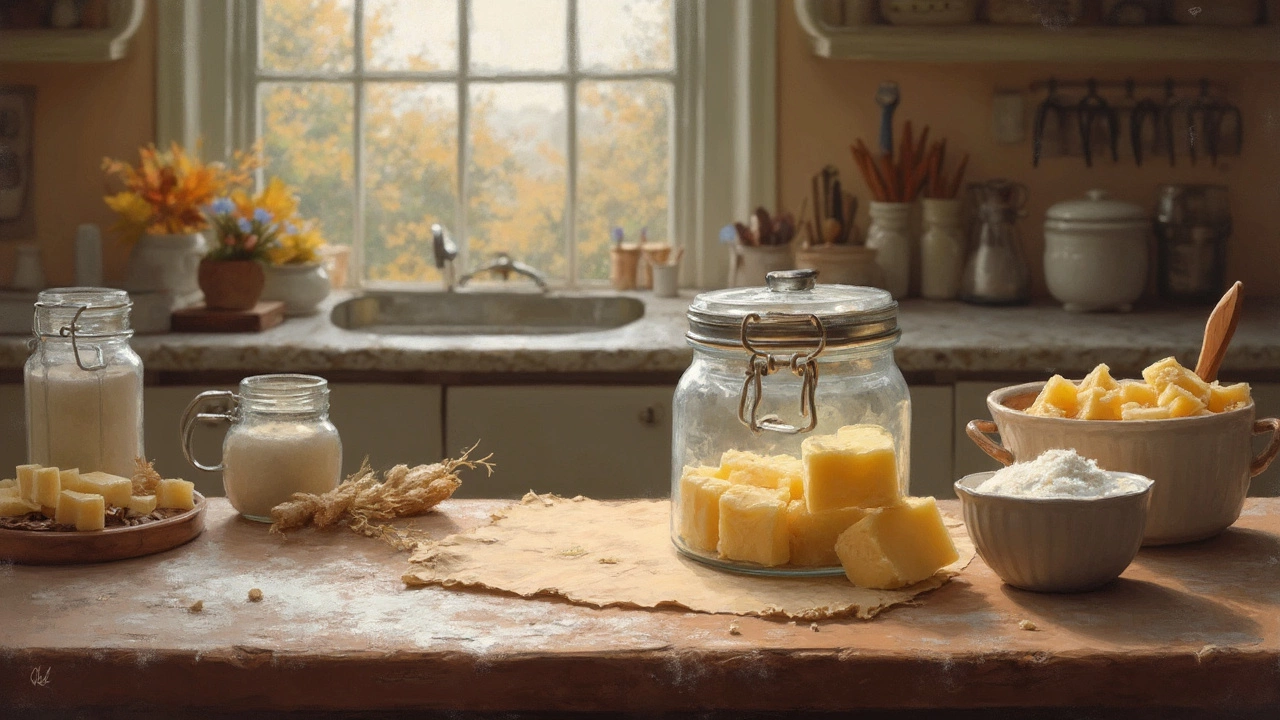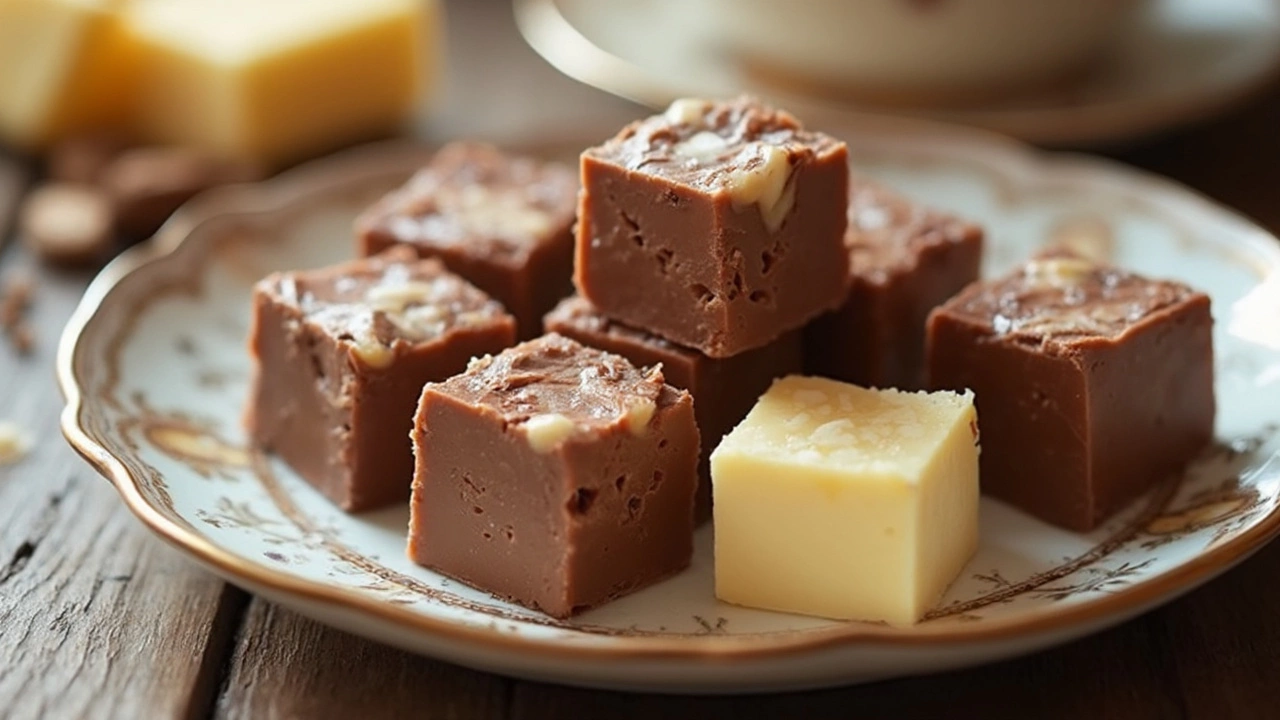
So, you want to whip up a batch of fudge, huh? It's all about getting those basic ingredients just right. The classic trio—sugar, butter, and milk or cream—are your essential building blocks. These three come together to create that smooth, melt-in-your-mouth texture we all adore.
Sugar is what makes fudge sweet and gives it structure. Now, imagine combining that with creamy butter; it’s a match made in dessert heaven. Milk or cream adds richness, turning the mixture into a luscious concoction. Even if you're not a kitchen pro, understanding this combo is your secret weapon to fudge success.
Of course, that's just the start. Most people love adding flavors like chocolate, vanilla, or even peanut butter to switch things up. So, don’t stop at the basics. Let your taste buds lead the way and you'll soon be enjoying homemade fudge that hits the sweet spot every time.
- The Fudge Foundation: Sugar, Butter, and Dairy
- Adding the Flair: Flavorings and Variations
- Troubleshooting Common Fudge Failures
- Tips for Perfect Fudge Every Time
The Fudge Foundation: Sugar, Butter, and Dairy
Diving into the world of fudge making starts with getting to know the core ingredients: sugar, butter, and dairy. These are your foundation for any homemade fudge recipe, making sure it has that rich, creamy texture we all love.
Sugar is the backbone of fudge. It goes beyond just sweetening; it acts as a thickening agent when it crystallizes. An interesting tidbit: the type of sugar matters. Granulated sugar is the most common choice, but occasionally, you'll find recipes calling for brown sugar for a deeper flavor profile.
Next up is butter. It's what gives fudge that indulgent, creamy mouthfeel. The fat in butter also helps in reducing the size of sugar crystals, making your fudge smooth rather than grainy. Remember, good fudge doesn’t skimp on butter—you’ll want the real deal for the best results.
Then we have dairy. It’s typically milk or cream, and here’s where you can play a bit. Evaporated milk is a classic choice due to its low water content, thicker consistency, and usefulness in helping fudge set properly. Cream can make fudge even richer, while condensed milk adds sweetness.
Minding these foundational elements ensures a solid start. When you mix them right, the fudge will have a perfect base. Make sure your sugar is dissolved during cooking to avoid any unpleasant grittiness. Simmering your mixture till it reaches ‘soft ball’ stage, approximately 115°C (239°F), makes it prime for setting nicely later. Cooking temperatures can vary with dairy type, so a candy thermometer is your trusted friend here.
Understanding and taking care of these basics helps you avoid the usual pitfalls of making fudge. There’s a touch of magic in blending these ingredients seamlessly, but also a lot of science, believe it or not. And nailing that can make the difference between a delicious batch that disappears quickly—or one that’s best left quietly in the tin.
Adding the Flair: Flavorings and Variations
Alright, so you've got the basics down, but what makes fudge truly special? It's those extra touches—the flavors and variations—that can take it from familiar to WOW. Let's talk about how you can add some serious flair to your homemade fudge.
First off, chocolate is the ultimate crowd-pleaser. Whether you go for dark, milk, or white chocolate, it’s a no-brainer addition. Simply melt it into your mix, and you've added depth that takes fudge to the next level.
But why stop at chocolate? Vanilla extract is a classic that enhances any base recipe. A splash is often enough to lift the flavors. Want to be a bit adventurous? Try almond or peppermint extracts—they’re awesome for giving your fudge a festive twist.
Let’s not forget about nuts! Walnuts, pecans, or almonds can add a delightful crunch that contrasts beautifully with the creamy texture. Just stir them in once your fudge mix is ready.
For those with a knack for trying new things, here’s a fun stat: about 60% of fudge lovers enjoy adding unexpected elements like sea salt or chili flakes to their recipes. Why? They add a surprising twist to the sweet vibes, making taste buds do a happy dance.
- Fruit and Berries: Dried fruits like cranberries or apricots bring a chewy, natural sweetness.
- Peanut Butter: Swirl it in and get that perfect salty-sweet combo.
- Spices: Cinnamon or a dash of cayenne can warm things up.
- Cookies and Candy: Crush them and mix them in for texture and a sweet punch.
With so many possibilities, you can really make your fudge recipes unique. So get creative, experiment with different flavors, and you might just stumble upon a new family favorite.

Troubleshooting Common Fudge Failures
Even with the best intentions, making fudge can sometimes go a bit sideways. But don't worry—you're not alone! Let's tackle some typical fudge mishaps and show them who's boss.
First off, if your fudge turns out grainy instead of smooth, the sugar's likely the culprit. This usually happens if it hasn't fully dissolved. To prevent this, make sure to dissolve all the sugar before the mixture reaches a boil. Stir gently and consistently. If you're already dealing with a grainy batch, you might try reheating it with a little water to dissolve the sugar again.
Has your fudge gone from a delightful treat to a thick, sticky mess? That might be due to cooking it for too long or at too high a temperature. A simple fix for next time is to use a candy thermometer and ensure you're hitting that sweet spot of 234 to 240 degrees Fahrenheit (112 to 116 degrees Celsius).
Another issue folks face is fudge that ends up too soft. If that's your situation, it might be because it didn't reach the right temperature or needed more time to set up. Once again, that trusty candy thermometer is your friend to make sure the temperature is on point. If you're already stuck with soft fudge, try putting it in the fridge to help it firm up a bit.
And here's a quirky tip for you: sometimes, a drop of lemon juice can prevent sugar crystallization that leads to grainy fudge. It's like a little kitchen hack passed down through the ages.
Don't be disheartened if your first tries aren't perfect. Each batch is a learning experience pushing you closer to that ideal fudge consistency.
Tips for Perfect Fudge Every Time
Making fudge seems like you need wizard skills, but really it’s all about nailing the basics and not rushing things. To get that flawless, melt-in-your-mouth fudge, here are some handy tips to keep in mind.
First, always use high-quality ingredients. It’s tempting to grab the cheapest on the shelf, but the better the ingredients, the better your fudge will taste. Trust me, it makes a world of difference. Also, try to use unsalted butter—it lets you control the saltiness of your creation. If you only have salted butter, just skip adding extra salt.
Next up, temperature is key. Use a candy thermometer; it’s not negotiable! You want to reach that magic number between 234°F and 240°F—known as the 'soft-ball stage.' This sweet spot helps your mixture set properly without turning into a hard, crumbly mess. No thermometer? You can test a drop of the mixture in cold water; if it forms a soft ball, you're golden!
Watch the stirring too. Once it reaches the right temp, you need to cool it down before mixing some more. Stirring too soon? Say hello to grainy fudge. Let it chill to about 110°F before you give it a good mix to get that desired creaminess.
- Be patient! Rushing it is the number one way to mess things up.
- Store your homemade specialty in an airtight container. Air makes fudge lose its magic quickly.
- If fudge seems like it’s not setting, stick it in the fridge for a couple of hours—it usually sorts itself out.
These tips for perfect fudge are your new BFFs in the kitchen. Tweak and test till you find what works best for you. And hey, if things go sideways, you can always scoop it over ice cream and call it gourmet!